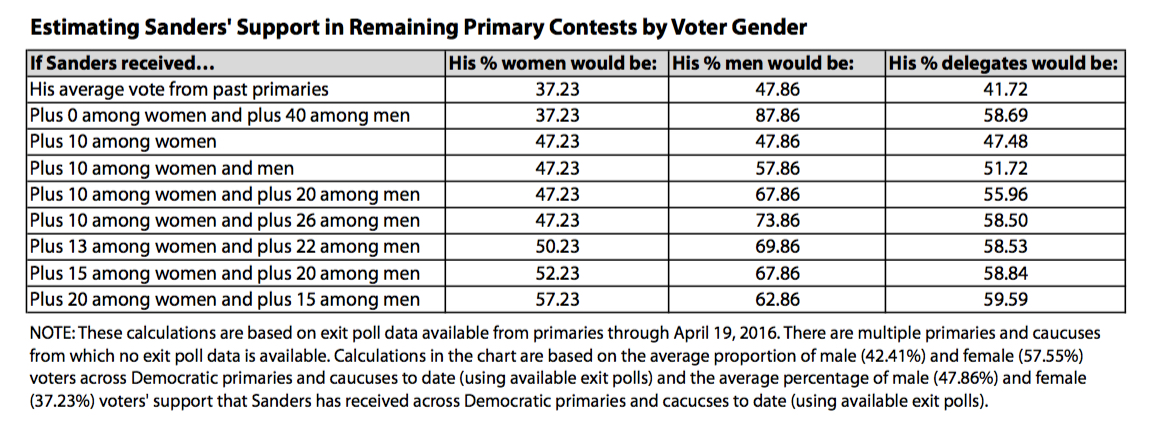How many women’s votes does Bernie Sanders need to win the nomination? (UPDATED 5.2.16)
 In April 2015, the Barbara Lee Family Foundation (BLFF) and the Center for American Women and Politics (CAWP) launched Presidential Gender Watch 2016, a project to track, analyze, and illuminate gender dynamics in the 2016 presidential election. With the help of expert scholars and practitioners, Presidential Gender Watch worked for 21 months to further public understanding of how gender influences candidate strategy, voter engagement and expectations, media coverage, and electoral outcomes in campaigns for the nation’s highest executive office. The blog below was written for Presidential Gender Watch 2016, as part of our collective effort to raise questions, suggest answers, and complicate popular discussions about gender’s role in the presidential race.
In April 2015, the Barbara Lee Family Foundation (BLFF) and the Center for American Women and Politics (CAWP) launched Presidential Gender Watch 2016, a project to track, analyze, and illuminate gender dynamics in the 2016 presidential election. With the help of expert scholars and practitioners, Presidential Gender Watch worked for 21 months to further public understanding of how gender influences candidate strategy, voter engagement and expectations, media coverage, and electoral outcomes in campaigns for the nation’s highest executive office. The blog below was written for Presidential Gender Watch 2016, as part of our collective effort to raise questions, suggest answers, and complicate popular discussions about gender’s role in the presidential race.
After 38 Democratic Party primaries and caucuses, Hillary Clinton is leading the race for pledged delegates by just under 250, and outpacing Bernie Sanders among superdelegates by more than a 13:1 ratio. The electoral math appears increasingly challenging for a Sanders nomination, but the Sanders campaign has remained steadfast in its willingness to take on this challenge. As pundits, practitioners, and statisticians calculate how Sanders could forge a path to victory, it is worth asking what role women voters might play in determining Sanders’ fate.
The team at FiveThirtyEight.com, who have been keeping close tabs on delegate counts and projections, reported that Sanders would need about 59% of remaining delegates after last week’s New York primary to catch up to Clinton. Using this estimate, we did some calculations about what the gender breakdown of Sanders’ resurgence might look like. Based on these calculations, Sanders would very likely need to win at least half of all women’s votes in remaining Democratic races, in addition to widening his margin of victory among men.
To date, Hillary Clinton has earned 61% of women’s primary votes, at least in states where exit polls are available. Bernie Sanders has earned an average of 37% of women’s primary votes. Fifty percent of men report voting for Clinton in exit polls, just two points higher than Sanders’ average of 48% of men’s votes. The gender gaps in support for Clinton and Sanders matter even more, however, given the gender differences in primary and caucus turnout. Again, based on available exit polls, women have made up a larger percentage of primary voters than men by an average of 16 points; across exit-polled states, women are 58% of voters and men are just over 42%.

These data indicate that closing the delegate gap for Sanders will require that he close an even larger gap in Democratic voters’ support in the remaining contests. Of course, Sanders could increase his share of the overall vote in upcoming states by increasing the gender gap in his support, but that would require winning nearly 90% of men’s votes (if he does nothing to increase his average support among women). A more realistic path to victory requires increasing his margin of support among women and men. For example, if Sanders earns 50% of women’s votes in remaining primaries – and if women remain about 58% of the primary electorate in those contests – he would need to increase his average percentage among male voters by 22 points (to 70%) in order to reach an average of 59% support across contests. Of course, if Sanders could increase his average support among women voters by 20 points, to 57%, in remaining contests, he would only need to increase his margin among men by 15 points, on average, to reach 59% of remaining votes and, thus, delegates.
As these calculations show, there is no magic number of women’s votes that Sanders needs to make a successful comeback in the Democratic contest. However, they present an important reminder that any realistic resurgence will require a more significant shift in Democratic women voters’ support than in men’s primary allegiances. That task will be tough, but is not yet impossible.
UPDATE as of May 2, 2016
After 43 Democratic Party primaries and caucuses, Bernie Sanders will need about 70% of remaining delegates (according to calculations from New York Times’ The Upshot) to win the Democratic nomination. We have updated our estimates of votes by gender to determine that Sanders would need significant increases in both women’s and men’s votes in remaining primaries to reach that average. More specifically, he would likely need nearly 80% of men’s votes and a majority of women’s votes to catch up to Clinton.



